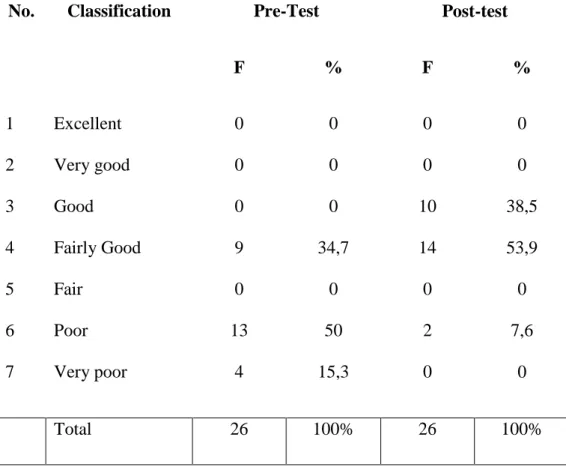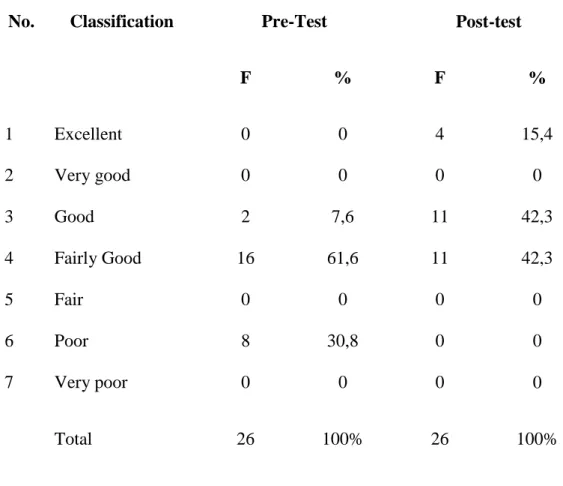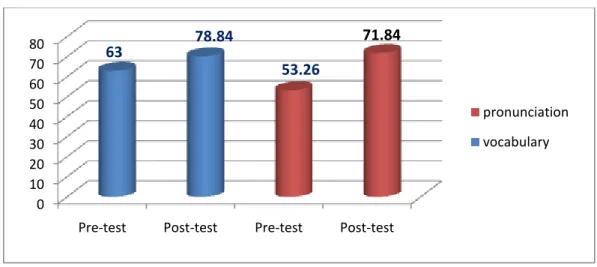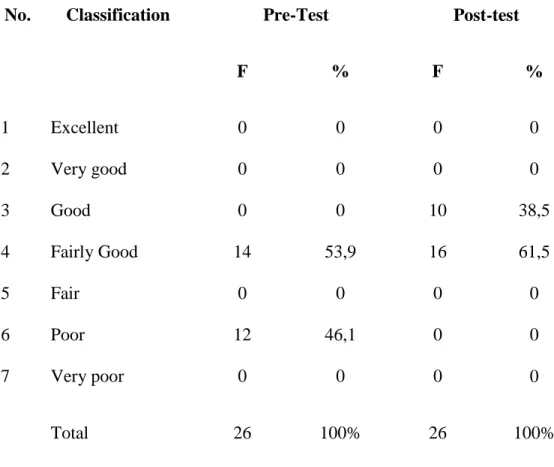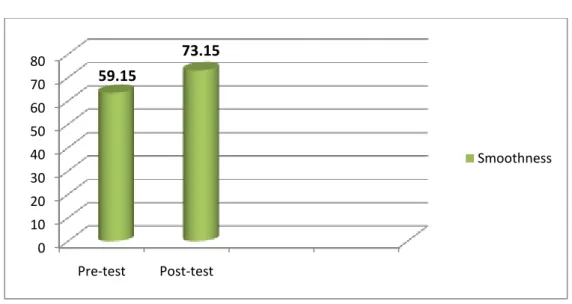Judul Skripsi: Improving Students' Speaking Skills Using Examples, Non-Examples, Method in Eighth Grade Students SMP Somba Opu Gowa (Experimental Research). Improving Students' Speaking Skills Using Examples, Non-Examples, Method for Eighth Grade Students SMP Somba Opu Gowa (Experimental Research). The purpose of the study was to find out if there is any improvement in the speaking skills of the students, focusing on the accuracy and fluency of the students through examples, not examples.
This research used Pre-experimental method which applied examples non-examples method to learned speaking ability. The population was the eighth grade students of SMP Somba Opu Gowa in the academic year 2016/2017. Total number of population was 56 students and class VIII.A consisting of 26 students was sampled using purposive sampling technique.
While the students' average score of vocabulary was 63 in pre-test to 78.84 in post-test. The researcher concluded that teaching speaking using examples non-example method increased the students' speaking ability in terms of accuracy and fluency at the Eighth grade of SMP Somba Opu Gowa.
INTRODUCTION
- Research Problem
- Objective of the Research
- Significance of the Research
- Scope of the Research
According to Istarani (2012:9), the method of non-examples is a teaching model which presents the materials to the students by showing the relevant pictures and the students have the opportunity to analyze the pictures individually or in groups and discuss about the picture. Furthermore, Kagan (1992:32) stated that he believes that in applying non-example examples, teachers should consider two principles: (1) Examples refer to real samples given by teachers through pictures related to the topic being discussed. and that they should be understood by students, and (2) Non-Examples are samples that do not match the topic being discussed. The hope of the researcher that the use of non-example example method can improve students' speaking ability and the use of picture as media.
Based on the explanation, the researcher was interested in conducting a study 'Improving students' speaking skills using examples, non-examples method for eighth grade students SMP Somba Opu. The teacher can use the image to present the lesson material to the students. Hopefully it can help the students improve their speaking skills by using the non-example method in learning to speak.
And the researcher hopes that this research can be used by the next researcher as one of the references in conducting research on English language teaching, especially in the implementation of the 'use of examples instead of examples' method. In this study, the researcher limited herself to the use of examples and non-examples, a method to improve the speaking skills of the students, focusing on the accuracy (pronunciation and vocabulary) and fluency (fluency) for the students of the eighth grade of SMP Somba Opu.
REVIEW OF RELATED LITERATURE
Some Pertinent Ideas
- Concept of Speaking
- Concept of Examples Non-Examples
Conceptual Framework
Introduction: Teaching material, Before implementing the method in the classroom, the researcher has made observation in the classroom. Process: Treatment given using Non-Examples, the researcher applied non-example as a method in a group class. Result: The treatment that was done in the research process is evaluated the interest of the students and how effective is the use of examples of the non-example method in teaching speaking skills.
Hypothesis
There is a significant difference between the students who were taught by example not using example as a method to increase students' speaking ability. There is no significant difference between the students who were taught by examples not examples as a method to increase students.
RESEARCH METHOD
- Variables and Indicators
- Population and Sample
- Research Instrument
- Procedure of Collecting Data
- Technique of Data Analysis
Post-test used after treatment to measure student improvement and understanding of the material through examples, not examples method. The students' pronunciation score in the pre-test was 53.26, it increases in the post-test as 71.84. Therefore, the improvement of students' speech accuracy, which consisted of pronunciation and vocabulary from pre-test and post-test, was significantly increasing.
The above table proved that the use of example method without examples in the teaching and learning process improved the students' speaking accuracy after taking the pre-test and the standard score was achieved after the test. Based on Table 4.3, it was evident that the student's post-test pronunciation achievement score improved after teaching using examples without examples. Based on Table 4.4, it can be seen that the students' vocabulary achievement score in the post-test improved after teaching using examples without examples.
The average score of the students in pre-test was 63 and post-test which was 78.84. Therefore, the improvement of students' fluency performance increased significantly from pre-test to post-test. Based on the table 4.6 showed that the score of students' fluency in terms of smooth performance in post-test improved after teaching by examples not using examples.
The explanation above indicates that using the examples non-examples method can improve the students' pronunciation. As a result, the average score of the students' speaking vocabulary in pre-test was still low. The explanation above indicates that using the examples non-examples method can improve the students' vocabulary.
Improving students' speaking in terms of fluency Using the method of examples not examples made students‟.
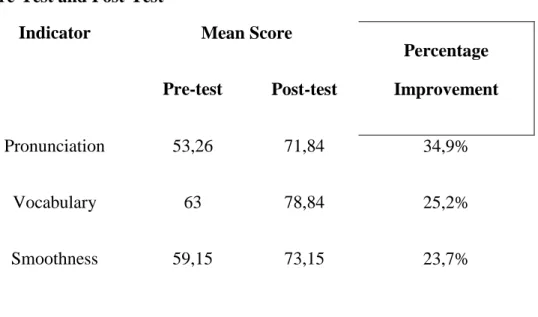
FINDINGS AND DISCUSSIONS
Discussion
After the researcher gave treatment using examples not examples method and then gave a post-test, the findings were that some students spoke correct and appropriate pronunciation and also some of the students' pronunciation was only very slightly influenced by mother tongue . From the data collected in the post-test, the researcher can deduce the students' accuracy and fluency using examples non-example methods in speaking, because they are easy to understand learning objectives and the activities during the teaching and learning process can be enjoyed. In this part, the researcher would like to contribute some suggestions for the students', English teachers and further researcher, based on the research findings and discussion.
Siswa mendengar dan menyaksikan banyak contoh interaksi dengan bertanya dan mengungkapkan pikiran serta jawaban dalam bahasa Inggris dari film, kaset, buku teks, dan lain-lain. Siswa meniru contoh interaksi dengan bertanya dan mengungkapkan pikiran serta tanggapan dalam bahasa Inggris dengan pengucapan, tekanan kata, intonasi dan postur yang benar. Siswa membandingkan ungkapan bertanya dan mengemukakan pendapat serta jawaban yang telah dikumpulkan dari berbagai sumber yang disebutkan di atas.
Siswa membandingkan ungkapan meminta dan mengemukakan pendapat serta jawaban yang dipelajari di atas dengan ungkapan dari sumber lain, atau dengan ungkapan yang digunakan dalam bahasa lain. Dengan bimbingan dan arahan guru, siswa mengidentifikasi ciri-ciri (fungsi sosial, struktur teks, dan unsur kebahasaan) interaksi meminta dan mengemukakan pendapat serta jawabannya. Siswa dapat menulis teks lisan sederhana dan bertanya serta mengemukakan pendapat dengan unsur kebahasaan dan struktur teks yang benar.
Siswa mengetahui cara berkomunikasi dengan orang lain, bertanya dan mengemukakan pendapat dengan menggunakan unsur kebahasaan dan struktur teks yang benar. Siswa dapat berperilaku percaya diri ketika berkomunikasi dengan guru dan teman, bertanya dan mengemukakan pendapat dengan menggunakan unsur kebahasaan dan struktur teks yang benar. Siswa mencari contoh dan noncontoh dalam bertanya dan mengemukakan pendapat dari berbagai sumber.
Siswa menjelaskan perbedaan ekspresi bertanya dan mengutarakan pendapat serta jawaban yang didapat dari gambar yang ditampilkan. Dengan bimbingan dan arahan guru, siswa mengenali ciri-ciri gambar contoh dan noncontoh (fungsi sosial, struktur teks, dan unsur kebahasaan) interaksi yang memerlukan dan mengungkapkan pendapat serta jawaban. Secara bersama-sama, siswa berusaha mencari contoh dan noncontoh dalam mengajukan pertanyaan dan mengemukakan pendapat dari berbagai sumber.
Siswa menjelaskan setiap contoh dan noncontoh sehubungan dengan pertanyaan dan ungkapan pikiran yang diberikan guru. Siswa menerima umpan balik dari guru dan teman dengan cara bertukar pikiran tentang contoh dan noncontoh dengan bertanya dan mengemukakan pendapat. Siswa menggunakan contoh dan noncontoh untuk mencari dan mengungkapkan ide dengan memperhatikan struktur teks dalam kelompok.
Siswa menyusun percakapan dengan memperhatikan struktur teks berdasarkan contoh dan noncontoh bertanya dan mengemukakan pendapat.
